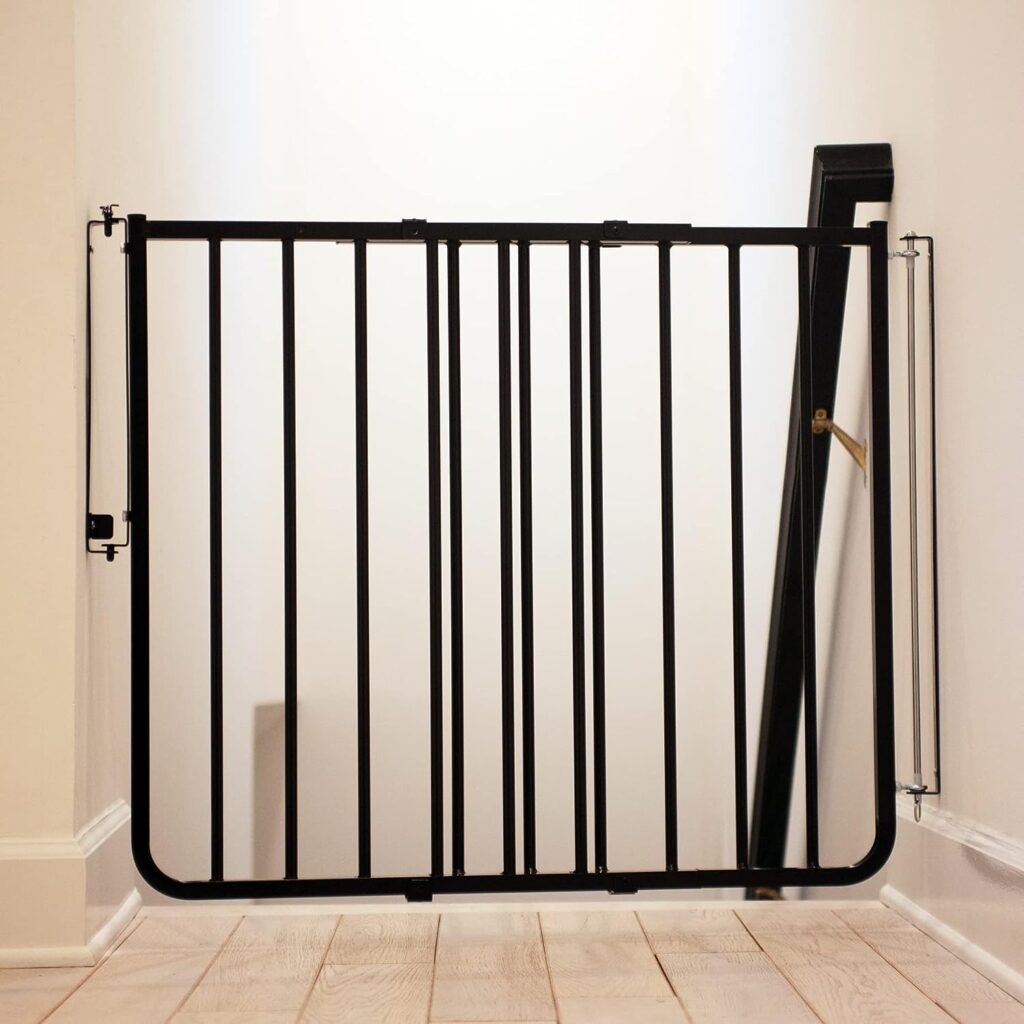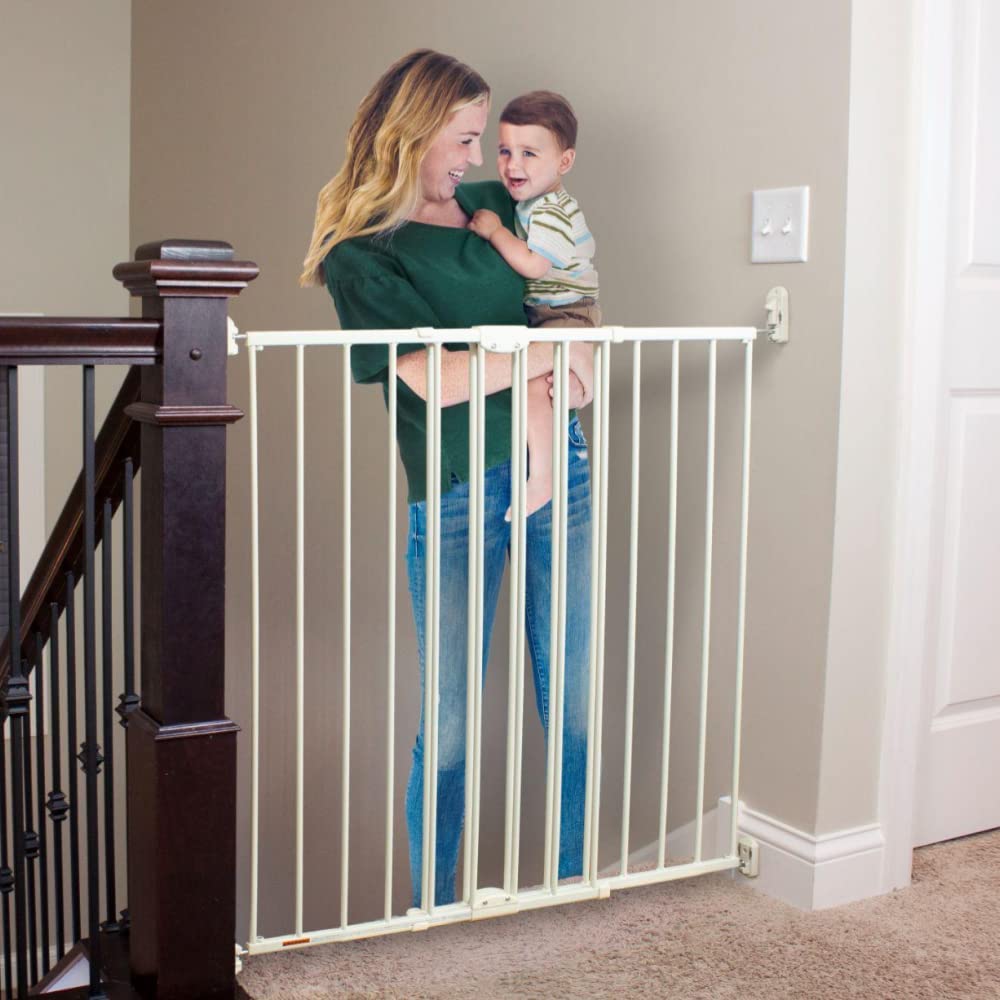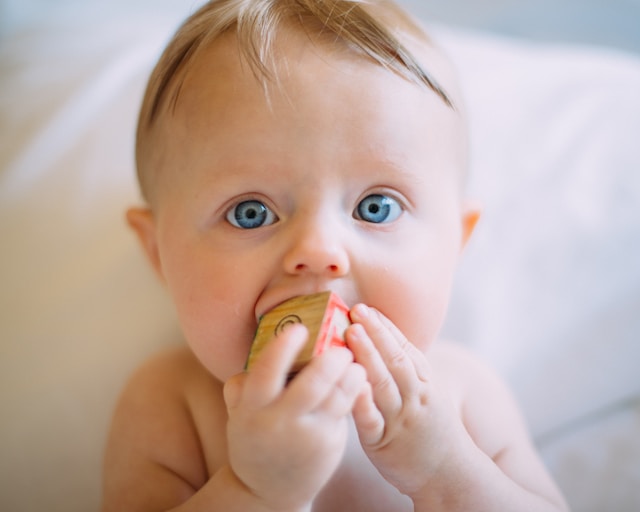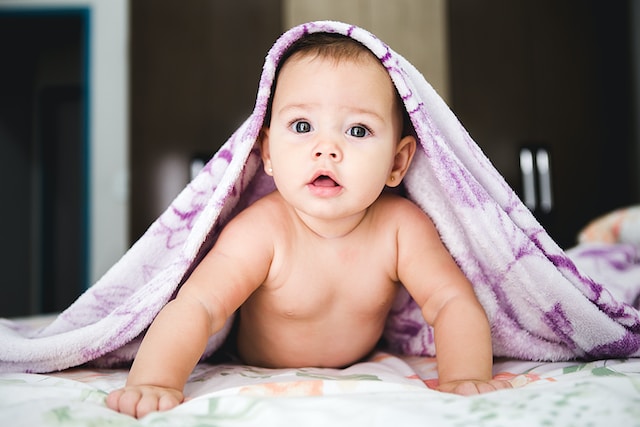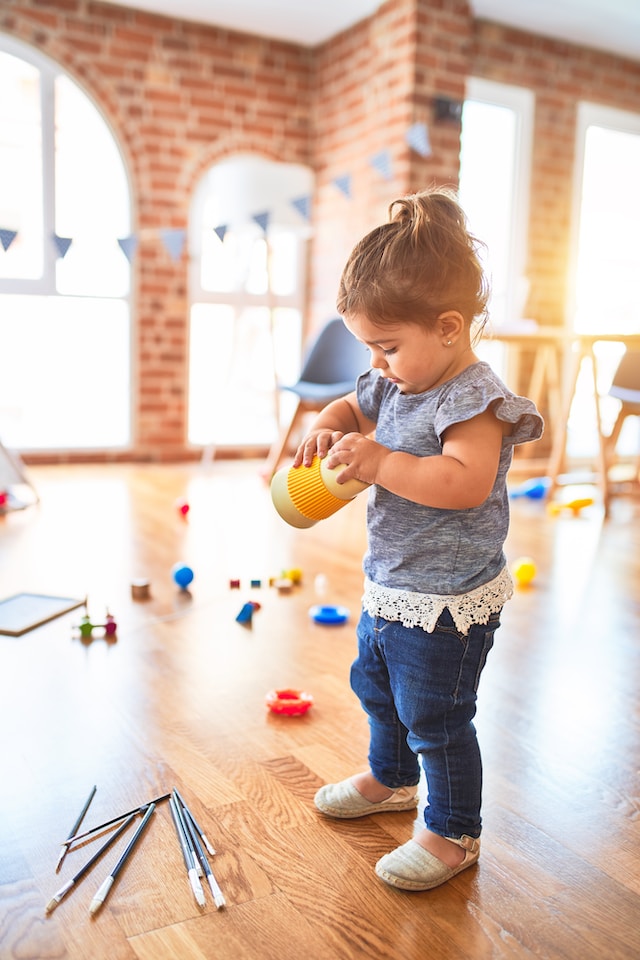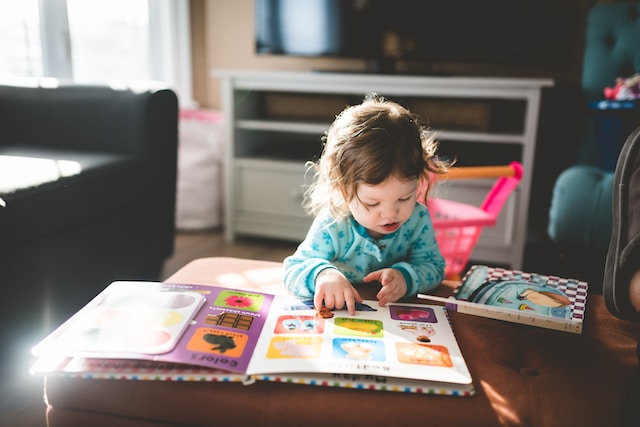The bathroom is the worst room in the house for babies and toddlers. It just is.
When my kids were that age, I remember thinking how much easier it would be if they could just nevergo in the bathroom. Everywhere you look, there are dangers:
- A slippery surface that could lead to a fall
- Hard floor to land on if that fall happens
- A sharp corner to bump a head-on
- Dangerous chemicals and medicines
- Water to drown in
- And, of course, gross germs everywhere.
The idea of baby-proofing just about everything in a room can be overwhelming. But don’t stress!
Below are some easy-to-follow tips and steps that will help you make your bathroom as safe as possible for your little one.
Let’s get started!
Why Baby Proofing Bathroom is Important?
There really is no getting around it: bathrooms are dangerous places. They contain hazardous substances, and they’re just so slippery!
In fact, the vast majority, around 75%, of bathroom injuries requiring medical attention come from falls, and 65% of those occur in the shower. Most of these injuries occur to children.
Sixty thousand- that’s 60,000, not 6,000- kids are taken to the emergency room every year for accidental ingestion of harmful substances.
That’s just two areas of bathroom safety. There are plenty more opportunities for people to get injured in their own homes while in the bathroom. Luckily, most baby proofing in the bathroom is pretty simple.
Even more, luckily, the babyproofing you do in your bathroom benefits the whole family. Adults also break bones when they slip in the shower or on the wet floor outside it. The entire family is safer when a few steps are taken to remove hazards in the bathroom.
When to Start Baby Proof Your Bathroom
All baby proofing is easier if you do it before your little one is even born. That way, you don’t have to try to baby proof while a baby is getting into everything at the same time. If you’re only going to do one room before a baby arrives, I recommend the bathroom.
There are many hazards in a bathroom for a newborn, as compared to other rooms where a lot of the hazards aren’t especially dangerous until a baby can start moving. Even very young babies enter the bathroom to be bathed, and it needs to be secure for them for that reason.
So get that bathroom baby-proofed before you bring your baby home!
How to Baby Proof Bathtub
Most babies get their first bath before they come home from the hospital. We don’t stop there, of course. This means that a bathtub is one of the first hazards your little one will be exposed to.
Bathtub drownings are a serious safety risk to all babies and young children.
There are some easy steps you can take to make bath time more about fun and less about stress. The easiest one does not involve any product:
Do not ever leave your child alone in the bathtub. Like ever. If you need to step away from the tub for a moment, grab the towel and bring the baby with you.
While bathing multiple kids together can be convenient and fun, older siblings are not adequate supervision until the sibling is old enough to be an actual babysitter for the little one in the tub (at which time they’re probably not taking baths together).
Here are some products to keep your little ones safer while they’re in the tub.
1. Faucet Cover
Most faucets have sharp corners, and all faucets are hard. They’re nearly always placed at just the right level for an older baby or toddler to hit their head-on. Even for older kids, it’s easy to raise up into a faucet and scrape their sides or back on it.
Faucet covers are an easy way to solve this problem. They are typically a fun-looking plastic tube that slides over a faucet with openings on top for shower levers and on the bottom to let the water out.
When selecting a faucet cover, you’re going to want to check if it has an opening on top if this is required for using your shower features. You’ll also want to make sure it fits your faucet well and especially that it stays on. I’ve used some before that slip off continually, which makes them pretty much useless.
You’ll also want to explain to your child that this is not a toy and that they are to leave it on. Faucet covers typically look very much like bath toys. This is another reason I like the PUJ one. I’m not sure why, but my kids have always left this one on.
2. Bath thermometer
Baby skin is much thinner and more sensitive than adult skin. This means that babies are easily burned by water that would feel acceptable to adults. Some people test bathwater for little ones by putting their hand or wrist in it. This is unreliable.
Because we are used to using much warmer water for ourselves, it can be tough to tell if water is too warm for little ones. Also, the water temperature best for babies can feel too cool to some adults.
A bath thermometer is a better option.
There are lots of items on the market that aren’t actual thermometers but have a “too hot” indicator on them. This is often a rubber duckie-type toy with a heat sensor on the bottom. These are very unreliable and have been known to call cold water “too hot” and not indicate that hot water is too hot.
3. Shower mat
Showers are made of slippery substances. Then they are coated with water and often slippery soap. This can be a hazard even for adults.
A solution to this is to purchase a shower mat or grippy stickers for your shower floor. Both options seem to be equally effective and efficient.
If you choose to use a mat, it will need to be checked periodically to make sure it is not growing mold and hasn’t slipped out of place.
If you chose to use stickers, you would need to keep an eye on them and replace them if they begin to peel off.
4. Baby Bathtub
An option for younger babies is a baby bathtub. This allows you to bathe them in a sink at a more convenient height for you. It also keeps them upright and safe in a bigger bathtub if you choose to bathe them there.
Some baby bathtubs are only for young infants who can’t sit yet. They are similar to a bouncy seat, but designed for water.
Some have a buckle sling or hammock for newborns and very young babies that can be removed.
The rest of the tub is marketed as being usable through toddler years, but I have yet to come across a family that still uses a special bathtub for toddlers.
There is also a style that is like a small bathtub that you insert into your bathtub. These are not as useful before a baby can sit well, but could feasibly last through toddler years.
A trendy newer idea is to use a laundry basket in your bathtub for a toddler or a baby who can sit up. The holes in the laundry basket allow water from the tub to fill the basket but keep your little one contained in one spot.
Toys can’t float very far away, so a baby won’t reach for them and fall over, which happens so many times during a bath.
If you chose to use this option, you need to keep in mind that the bottom of a laundry basket can be very slick and challenging for your little one to sit on.
Definitely do not let them stand up in the basket or hold onto the side of it. You will need to line the bottom of it with a towel or preferably some of the grippy stickers designed for the bottom of a shower.
The laundry basket hack is not designed as a safety item for babies, so use it with caution and extra supervision. It may be a great idea if it works well for your family, as standard baby bathtubs can take up a ton of space to store between baths.
How to Baby Proof Toilet
Little kids love toilets. I don’t get it because toilets are disgusting (or is that why they like them?), but every kid I know has investigated a toilet a little more than their parents would like.
Toys or other items get thrown in and sometimes flushed. Little hands reach in to splash in the water at the bottom.
I once found an entire roll of unraveled toilet paper in mine (this was done by a kid who was old enough to be in a bathroom alone, but I have sympathy for parents of two-year-olds who find themselves with the same un flushable mess).
None of those issues compare to the actual safety risk of a toddler toppling headfirst into a toilet. Water is always a safety risk for kids, and toilets always have enough water in them to drown a small child.
Luckily, making a toilet safe can be super simple.
1. Toilet locks
There are several types of toilet locks, but they are all designed to keep a toilet lid closed when not in use.
They are also notoriously tricky for even adults, let alone older siblings, to get open so keep that in mind when selecting the right type for your household.
2. Safety Strap locks
Another kind of toilet lock is a safety strap lock. This same kind of lock is often used all over the home to keep kids out of fridges, cabinets, drawers, etc.
Both ends have squares of solid adhesive. One end is the female part of a buckle system. The other end is the male part and a strap. One end sticks to the side of the toilet and the other to the closed lid. You just unbuckle one side, similar to a car seat buckle, to open it.
Some versions unlock with a key, which would obviously be very difficult for a kid to break through, but would also be easy for a parent to lose. I imagine getting locked out of a toilet would be incredibly difficult.
I’m also not a fan of the idea of having to grab a key every time someone visits the bathroom with a stomach bug. For those reasons, I’m going to discuss the traditional kind of safety strap here.
- PROS: The versatility is a huge pro. Once parents and older siblings learn how to use these for one room, they also know how to use them for the toilet.These are not as permanent as some other toilet locks, but they do hold up well to tugging and yanking.Just this week, I watched my seven-year-old nephew yanking roughly on one, and it didn’t budge (he did eventually figure out how to open the fridge it was keeping him out of, but he’s seven, so that was no issue).
- CONS: They are adhesive, so they aren’t permanent. They are not especially washable and are an adhesive device on the side of a toilet, so you have to expect some gross grime to build-up.
3. Toilet Seat with Built-in Potty Training Seat
A nontraditional way to baby-proof your toilet is to use a toilet seat with a built-in child seat.
Your toilet will NOT be fully baby-proofed with this, to be clear. All a small child has to do to access the full toilet is to lift up the seat. But if your child is not especially curious and just needs a bit of a deterrent, this will help.
There will be a much smaller opening that will make it much more difficult for a child to get into the toilet or throw items in. These seats are nearly always equipped to close slowly to protect a child’s fingers. An added bonus is that you will have this ready when potty training time comes.
4. Toilet Seat with Built-in Potty Training Seat
Like the special seat above, this is not going to help with any safety issue, but if you have a flusher, a child who insists on flushing various items down the toilet (and I get it- it makes a cool sound, the items disappear and that’s mysterious, the adults get all worked up and that’s entertaining), you might find this type of toilet lock useful.
5. Toilet brush
Toilet brushes look like giant toothbrushes or hairbrushes. They look fun. They’re also probably the germiest item in your entire bathroom.
One option for keeping these away from curious little ones is to store it under your bathroom sink if you have a lock for that cabinet or in a closet. I always kept mine locked in a bathroom closet, but it was a bit inconvenient to carry it out every time I wanted to clean the toilet.
If you choose to keep your toilet brush next to your toilet, consider getting the kind of toilet brush container with a lid and using a safety strap to keep your little one out. Just make sure to attach the end with the strap to the container, not the brush itself.
How to Baby Proof Bathroom Cabinet
Your bathroom cabinets are likely some of the most dangerous cabinets in your home.
This is where we keep cleaning products full of dangerous chemicals, personal care products like toothpaste, shampoos, soap that would be harmful for a curious baby to taste, and medicines that look like candy and that kids see growns up eating all the time.
Who doesn’t know a little kid who gave themselves a nasty cut with a razor while trying to shave like mommy or daddy?
Securing these cabinets should be a priority on your baby-proofing to-do list.
1. Choose Products Carefully
A step you can take with this is to remove dangerous products from your home. It is never possible to remove all hazardous products, especially regarding medicines and health care products, but it is worthwhile to reduce the risk.
My oldest loved to eat his diaper paste as a baby. If I turned my back for two seconds to grab a new diaper, he’d get himself a disgusting baby-sized handful. He learned how to open that container year before he was able to open similar containers. He was just that motivated to eat diaper paste.
It was every bit as gross as it sounds. I mean, it was not food and didn’t smell like food. I dipped my fingers in the tub of paste right after wiping off his bottom and definitely never washed my hands in between.
But the diaper paste we used, CJ’s Butter, is 100% edible, so he was never harmed a bit.
CJ’s Butter The Original CJ’s BUTTer® All Natural Shea Butter Balm
It comes in amazing smells and makes a great lotion replacement for the whole family.
Toothpaste: Mainstream toothpaste require a call to poison control if “more than the amount used for brushing is consumed.” There is more “natural” toothpaste on the completely edible market. They rarely contain fluoride and often have a variety of unusual toothpaste ingredients, but many people swear by these types of toothpaste.
My kids and I have used them for years without any dental issues. I have one child who would still use toothpaste for a snack if given a chance, so I’m glad to keep natural toothpaste in the house.
Hello Oral Care Kids Fluoride Free Toothpaste for 3 Months+
Hello is my (and my kids’) favorite brand for this.
All three of mine love this flavor.
Surface Cleaner: While bleach is a great cleaner, homemade vinegar sprays and essential oil sprays have been tested and shown to do an outstanding job killing germs also.
It would not be safe for a toddler to drink either vinegar or essential oil spray, but it would be monumentally less harmful than it would be for them to drink bleach.
If bleach wipes are your thing, check out the Clorox brand’s hydrogen peroxide wipes. Again, you don’t lose any cleaning power, but you have a substance in your home that is less harmful to a little one.
My favorite alternative to soap and shampoo is castile soap. Again, do not allow your child to drink this, but it would not be an emergency if they did. You can use this to replace traditional toxic hand soap, body wash, toilet cleaner, surface cleaner, vegetable wash, dish soap, dishwasher soap, and even laundry soap. Puracy brand also carries a lot of great personal care and cleaning products that are labeled as non-toxic.
2. Safety Straps
All that said, bathroom cabinets are still going to be dangerous. There are no safe alternatives for many of the items we keep in there. For that reason, it is highly recommended that you use some sort of lock to keep children out of these locations.
It is much less important that these types of locks are usable by older siblings as most older kids do not need access to the things stored in bathroom cabinets. For this reason, it may be a good idea not to use the same baby-proof equipment as you use in the rest of your house.
Safety straps described in the section above work great for bathroom cabinets, but do not use them if you have taught older children how to use them. If this is not the case, safety straps are an excellent choice for this location.
3. Cabinet Latches
Cabinet latches work well for both drawers and cabinets—these work by screwing a long latch onto the door or the drawer.
A catch is screwed onto the inside edge of the cabinet or drawer and holds it shut once it’s closed. You have to press down on the latch to get it unattached from the catch to open.
These work well and are quite hard for little ones to figure out.
They leave permanent screw holes in your cabinets, though, and eventually, the latch gets misshapen and no longer sticks to the catch.
4. Sliding Locks
Sliding cabinet locks are a great option if you have two cabinets with handles that are close to each other.
This type of lock typically comes in a “u” shape. One end of the “u” slides through the handles of the cabinet. Then you slide on the locking piece. It won’t reopen unless you squeeze and remove the locking piece.
This type of lock is extremely hard for kids to get into. In fact, it sometimes has a reputation for being difficult for parents also, but I believe that’s worth it for a bathroom cabinet containing substances like bleach.
How to Baby Proof Bathroom Counter
There are two types of bathroom counters:
The “nothing belongs here except soap” type, and the “This is where I keep everything I ever use in the bathroom” type.
Usually, I say “you do you” and use that counter however you want. But when it comes to baby-proofing, the first type is much safer.
1. Clean Off the Counter
The first step for baby-proofing your counter is to put things away. Just everything. If it’s on your counter and you don’t want your small child to get into, find a new home for it.
Electric hair appliance? Put it away. Those can be burn hazards.
If you choose not to store them elsewhere, make sure that you are with the appliance while it is warm, even after you’re done using it. You’ll also need to make sure to unplug them after every use so that a kid won’t accidentally (or intentionally) turn them on by pressing the buttons.
Seriously, buttons draw toddlers in like nothing else. It might be annoying when your child goes crazy pressing all the buttons on the TV remote. It’s just dangerous when they press the buttons on a curling iron and turn it up to 500 degrees.
Shaving equipment? DEFINITELY put it all away.
Razors are highly dangerous but seem to be an item that kids like to experiment with while doing adult pretend play.
Shaving cream is easy for kids to spray on their own. It actually makes for great sensory play, but this needs to be done under adult supervision. Make-up and make-up equipment? Put it away.
First of all, think of the mess that could result from a kid getting into that.
Second, younger kids want to taste everything they get their hands on. Make-up is full of chemicals that should not be eaten.
Even toothpaste needs to be stored in a secure location. It can cause serious health problems if it’s eaten. And it’s very tempting to little kids to eat: it comes in delicious flavors and is made to go right in their mouths.
2. Corner Guards
If your counter has sharp corners, you can protect little heads by installing corner guards.
These are foam or plastic pads that act as a cushion if someone bumps into the corner.
How to Baby Proof Bathroom Floor
Bathroom floors are nearly always hard and slippery. Then we add water when it drips from us after a shower. This creates a huge falling hazard for older kids and adults as well as little ones.
To make it worse, bathrooms are typically small and filled with very hard objects like a bathtub. This means that if someone does fall, they’re likely to hit their head on something hard.
Making a few adjustments to your bathroom floor will greatly reduce this risk.
1. Rugs
Bathroom rugs are your best bet for baby-proofing your bathroom floor. They make the floor softer in the event of a fall and make falls less likely by absorbing water and creating a less slippery surface.
Any rug designed for a bathroom should work well, though pay attention to the backing.
You’re going to want to select a rug that has a grippy back or else purchase a rug stopped to place under it. If not, the rug could slip around and be more of a hazard than the bare floor.
2. Be on Alert for Spills and Splashes
Make sure you wipe up water on the bathroom floor as soon as it happens. Most bathroom floors are slick, and toddlers are already unbalanced. Slipping in the bathroom means a lot of hard surfaces to hit head-on.
If water splashes out of the bath drips off someone who steps out of the shower, or sloshes out of the sink, wipe it up right away.
Some Do’s and Don’ts
Do’s
- DO choose bath toys carefully. At first glance, it seems like any plastic, waterproof toy is safe for a bath. But many toys not designed for baths contain chemicals that are not problematic if a child plays with them while dry but will enter the water in a bath and can be absorbed in a child’s skin. In addition, because baths are so slippery, toddlers and babies are often tumbling over even while sitting in there. Make sure they don’t have any toys with sharp or pointed edges.
- DO consider installing a lock on the bathroom door that a little one can’t reach or putting a baby gate in the doorway. You’ll still need to baby-proof your bathroom if you do this because there is no way to avoid ever bringing your child into the bathroom, but this could help.
- DO periodically check bath toys for mold. Water gets trapped in them, and nearly all will eventually develop mold. Mold is not healthy for little ones, and you definitely don’t want to bathe your child in a tub of moldy toys.Look inside any toy that has holes for draining or spraying out water. If you see mold inside, throw it out. That is not cleanable.
Don’ts
- DON’T use rubber bands, hair ties, etc., to hold together bathroom cabinets doors. This may be an acceptable shortcut for keeping a baby out of cabinets in their own room, so they don’t scatter their clean diapers around the room and make a huge mess, but a bathroom cabinet is not the place to take shortcuts.
Final Words
Bathtime can be relaxing for adults as well as babies. It should be. Taking a few steps to make sure your bathroom is safe for everyone will allow your whole family to enjoy bath time and not feel stressed over everything that could go wrong. You got this!



